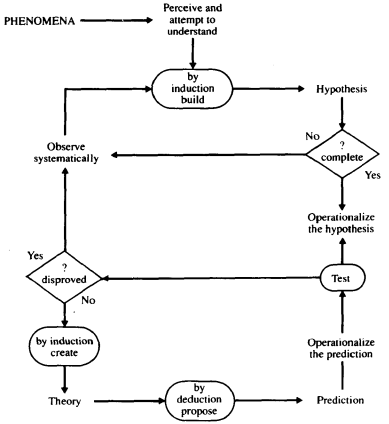It is difficult to imagine a better example of an issue which cries out for empirical investigation. If we ask what the unit is that the translator actually processes in the course of translating, we discover that there is good psychological and linguistic evidence to suggest that the unit tends to be the clause. There is also experimental evidence which supports the notion of co-occurrence between cognitive 'chunk' boundaries and syntactic boundaries within the clause; boundaries between

FIGURE 1 The cycle of enquiry
major structural units (Subject, Predicator, Complement, etc.) and the forms which realize them (phrases for the most part). For example,
the United Nations Secretary General reported substantial progress in the peace negotiations in Geneva today
would be likely to be segmented during reading into five or six units:
[the United Nations Secretary General]
[reported]
[substantial progress in the peace negotiations]
[in Geneva]
[today]
or
[the United Nations Secretary General]
[reported]
[substantial progress]
[in the peace negotiations]
[in Geneva]
[today]
and not
[the United]
[Nations Secretary]
[General reported substantial]
[progress in the]
[peace negotiations in]
[Geneva today]
nor even
[the United]
[Nations]
[Secretary]
[General re]
[ported sub]
[stantial]
[progress in the]
[peace negoti]
[ations in Ge]
[neva to]
[day]
as it would be in speech with the rhythmic boundaries (of the feet) cutting through lexical and syntactic units.
We intend to approach translation issues in this way throughout the book, i.e. by providing text which illustrates the problem and working from that towards descriptive rules rather than prescribing or proscribing, a priori, what should be done.
责任编辑:admin
上一篇:交错配列修辞格
下一篇:僻论修辞格

微信公众号搜索“译员”关注我们,每天为您推送翻译理论和技巧,外语学习及翻译招聘信息。